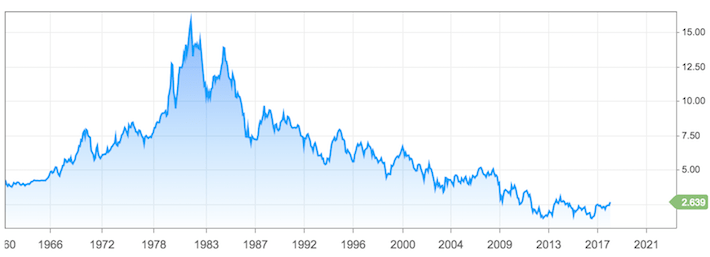
This piece will be focused on the T.I.N.A. market that we’ve all been investing in throughout the last handful of years. I’ll be taking a look at the risks and repercussions of such an environment, and how I’ve been dealing with it personally.
Many of you may not be familiar with the T.I.N.A. acronym. I’m not sure when/where/who officially coined it, but it stands for:
“There Is No Alternative”
This is referring to historically low interest rates driving income oriented investors (both retail and institutional) into equities (and therefore, higher risk) because it wasn’t possible for them to meet their minimum yield thresholds in the fixed income markets. I understand why this has been happening and in certain cases, I can hardly blame investors/portfolio managers for the increased risk that they’ve exposed themselves to, but it’s a dangerous practice, nonetheless. What’s more, it’s not only potentially dangerous for the investors out there reaching for yield, but it poses risk to the entire market as a whole potentially toppling over due to an artificially inflated shareholder base.
The U.S. bond market has been in a raging bull market since the early 1980’s when the 10-year treasury yield topped out at nearly 15%. Since then, we’ve been on a fairly steady decline with the yield bottoming out in the ~1.4% range several times during our current decade. We saw an uptick of rates during 2013 and I remember analysts saying that it was time for the bull market to end. Well, flash forward to 2014, 2015, and 2016, and we saw that those prognosticators’ estimates couldn’t have been further from the truth.
However, the Fed has begun the normalization process with rate increases and plans to liquidate its balance sheet and rates are on the rise again. Murmurs of the generational bull market coming to a close are growing louder again and if they turn out to be true this time, the effects won’t be isolated to the security markets.

Source: CNBC
I’m not a professional money manager (I just manage my own), but I am friends with a handful of individuals working in the financial management industry and recently they’ve been telling me stories of historically conservative investors wanting to increase their exposure to equities today.
While this isn’t surprising because of the massive equity rally that we’ve seen over the last couple of years, it is worrisome. When the markets hit new record highs and post 20% annual gains, it’s easy to understand why some investors who were on the sidelines might feel like they were missing out. Greed typically doesn’t care much for valuations though, and exuberance is what leads towards unsustainable premiums and eventual corrections/crashes.
When the market corrects it’s usually the weak hands that end up folding. Sure, some responsible, rules based managers might strategically sell out of certain positions, locking in gains or setting up tax-time losses, but for the most part, it’s fear that rules those types of days and since both fear and greed are inspired by irrationality, it doesn’t take much for one to transform into the other.
Over at my website, I’m currently in the middle of writing a series titled, “No, The Stock Market Isn’t Rigged Against You,” in an attempt to prove to the masses who believe that the stock market is nothing more than a Wall Street Casino where the wealthy get more wealth and the Main Street investor gets swindled that their belief couldn’t be further from the truth. Please enjoy parts One and Two after you finish reading this piece, if you have the time.















